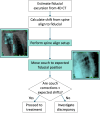A Quality Control Procedure for Single Fiducial Tracking of Lung Lesions
- PMID: 40510067
- PMCID: PMC12159563
- DOI: 10.7759/cureus.83935
A Quality Control Procedure for Single Fiducial Tracking of Lung Lesions
Abstract
Real-time adaptive motion management enables the synchronization of radiation delivery with the patient's breathing motion, thus reducing target margins and normal tissue exposure. The respiratory model is created by correlating the position of external markers placed on the patient's chest with the internal target position extracted from planar X-ray images. While a fiducial-less tracking algorithm is available for lung lesions with high radiographic contrast, many patients require the implantation of radio-opaque markers for localization. To limit the incidence of complications from the implantation procedure, a single fiducial marker may be implanted. As fiducials can migrate following implantation, it is important to verify the relationship between the tumor and the fiducial prior to treatment. The goal of this technical report is to provide a quality control (QC) procedure to assess the possibility of fiducial migration in lung patients treated on the robotic radiosurgery platform.
Keywords: anatomical alignment; breathing motion; dynamic tracking; fiducial migrations; rotational corrections.
Copyright © 2025, Descovich et al.
Conflict of interest statement
Human subjects: Consent for treatment and open access publication was obtained or waived by all participants in this study. Human Research Protection Program Institutional Review Board (IRB) - Mount Zion Committee issued approval 20-32527. Animal subjects: All authors have confirmed that this study did not involve animal subjects or tissue. Conflicts of interest: In compliance with the ICMJE uniform disclosure form, all authors declare the following: Payment/services info: All authors have declared that no financial support was received from any organization for the submitted work. Financial relationships: All authors have declared that they have no financial relationships at present or within the previous three years with any organizations that might have an interest in the submitted work. Other relationships: All authors have declared that there are no other relationships or activities that could appear to have influenced the submitted work.
Figures



Similar articles
-
Automated target tracking in kilovoltage images using dynamic templates of fiducial marker clusters.Med Phys. 2017 Feb;44(2):364-374. doi: 10.1002/mp.12073. Med Phys. 2017. PMID: 28035655 Free PMC article.
-
End-to-end validation of fiducial tracking accuracy in robotic radiosurgery using MRI-only simulation imaging.Med Phys. 2024 Jan;51(1):31-41. doi: 10.1002/mp.16857. Epub 2023 Dec 6. Med Phys. 2024. PMID: 38055419
-
Deep match: A zero-shot framework for improved fiducial-free respiratory motion tracking.Radiother Oncol. 2024 May;194:110179. doi: 10.1016/j.radonc.2024.110179. Epub 2024 Feb 24. Radiother Oncol. 2024. PMID: 38403025
-
Robust localization of poorly visible tumor in fiducial free stereotactic body radiation therapy.Radiother Oncol. 2024 Nov;200:110514. doi: 10.1016/j.radonc.2024.110514. Epub 2024 Aug 29. Radiother Oncol. 2024. PMID: 39214256
-
Planting the seeds of success: CT-guided gold seed fiducial marker placement to guide robotic radiosurgery.J Med Imaging Radiat Oncol. 2013 Apr;57(2):207-11. doi: 10.1111/j.1754-9485.2012.02445.x. Epub 2012 Sep 21. J Med Imaging Radiat Oncol. 2013. PMID: 23551782 Review.
References
-
- Respiration tracking in radiosurgery. Schweikard A, Shiomi H, Adler J. Med Phys. 2004;31:2738–2741. - PubMed
-
- Kilby W, Naylor M, Dooley JR, et al. Handbook of Robotic and Image-Guided Surgery. Amsterdam, Netherlands: Elsevier; 2020. A technical overview of the CyberKnife system; pp. 15–38.
-
- Stereotactic radiotherapy with real-time tumor tracking for non-small cell lung cancer: clinical outcome. van der Voort van Zyp NC, Prévost JB, Hoogeman MS, et al. Radiother Oncol. 2009;91:296–300. - PubMed
LinkOut - more resources
Full Text Sources
Research Materials
